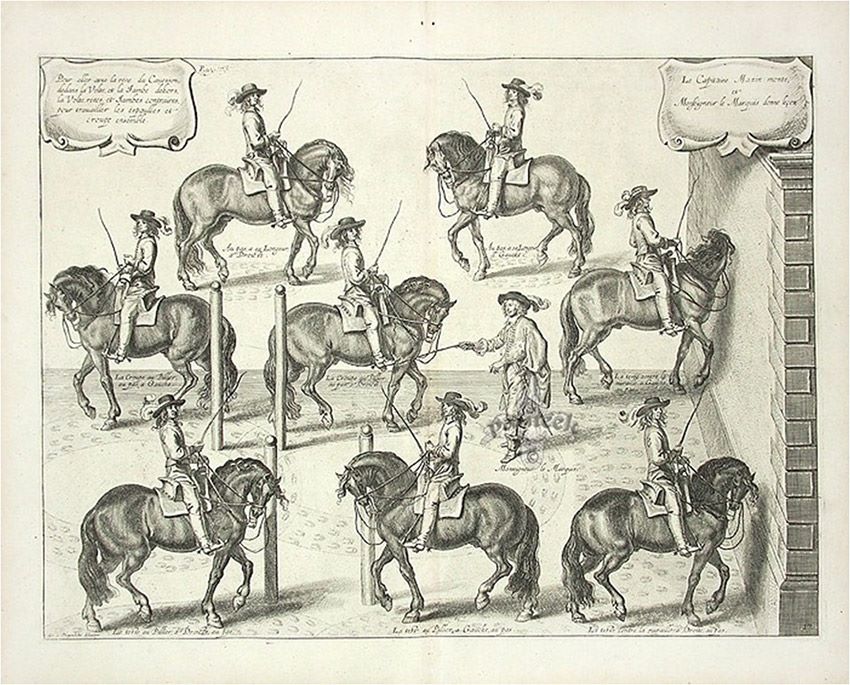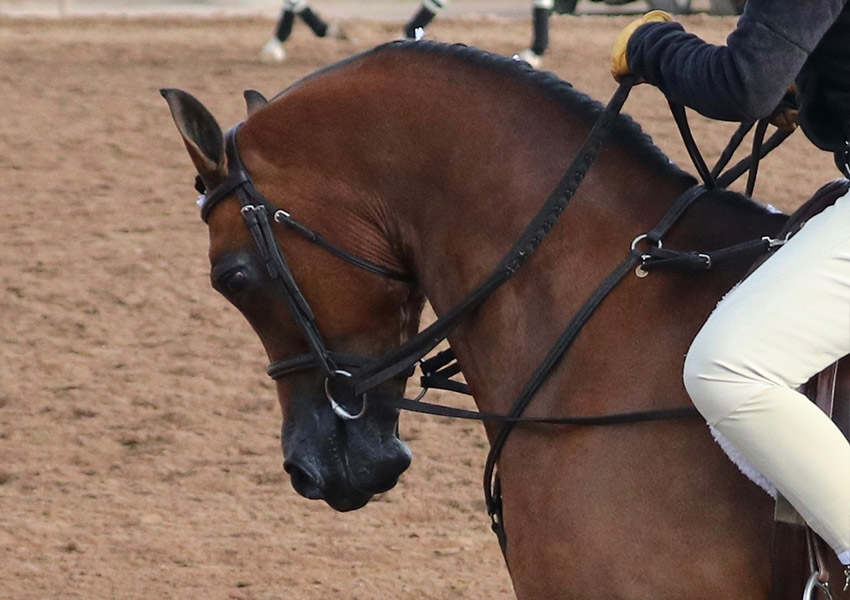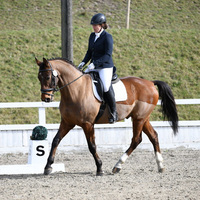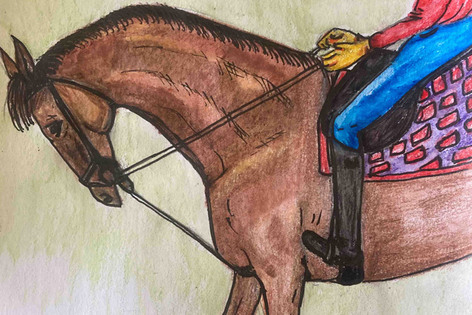As equestrians, we continually seek ways to enhance our communication with our horses and refine our training methods. One tool that still sparks controversy in the equestrian community is draw reins. In this article, we'll explore their purpose and the ongoing debate surrounding their use in today's equestrian practices with opinions from top professionals. Are they an effective teaching tool or just a torture instrument?
What are draw reins?
Draw reins are a piece of equipment used in horse riding that consists of a strap about 2.75m long that attaches to the girth, passes through the bit rings, and then into the rider's hands.
There are two ways to put on draw reins (see the diagram below). The more common way is to attach the draw reins at the bottom of the girth, so they go between the horse’s front legs, through the bit rings and into the rider’s hands. The less common variation is where the draw reins are attached to the girth but at the side. The difference is in the direction they act; the deep attachment pulls the horse’s nose to its chest, whereas the side attachment pulls the head back and up.
Draw reins are believed to have been invented by William Cavendish, the Duke of Newcastle, in the 17th century. He was not considered the most sensitive and is often called the spiritual father of “Rollkur”. According to period drawings, he used a cavesson. He would pass the draw reins through the rings of the cavesson and use them for lateral bending, with the help of a wall if necessary.
Why would you use draw reins?
In theory, the purpose of draw reins is to allow the rider to adjust the tension of the draw reins to encourage the horse to lower its head and neck, promoting a specific frame and outline. In Gerhard Kapitzky’s book, “The Horse from A to Z”, he says that horses with weak, stiff or anatomically unsuitable muscles of the back and neck are helped, without force, to stretch forward and down. This stabilises the arch starting at the back of the horse and ending at the chewing mouth. The slightly stronger action of the draw reins has to be counteracted by more engagement and collection of the back end. The rider has to use forward driving aids to achieve this, to prevent the rein aids from being more dominant; driving aids should always be stronger than restraining rein aids.
Draw reins should always be used as little as possible, only for short periods and only on one side, to carefully support the normal aids of the rein. As soon as the horse starts stretching forward and down, the draw reins need to come off. When draw reins are used on both sides at the same time and with force, the horse will come behind the vertical and avoid collection.
According to some riders and trainers, draw reins are used for horses whose body build makes it difficult for them to maintain a 'normal' posture; horses with a strong lower neckline, hard mouth, etc. When learning new exercises, some horses tend to push up. Correctly used, draw reins can be a good training aid when learning. A big problem is when riders use draw reins but don’t use enough forward driving aids. Then horses are inclined to get behind the bit and fall onto the forehand. So, only riders who know how to drive forward should use them.
Some think that correctly used, draw reins are a great training aid. Banning them just because they are often misused would be like banning cars, just because there are so many car accidents. Some say that it is better to use draw reins than to let the horse carry its head up and not use its back.

So, what is the problem with draw reins?
The problem begins with the strength in which the rider acts on the side rein almost doubles in terms of what is being felt by the horse. A group of scientists at a German University in Bochum discovered this when measuring the force of the reins. According to them, this is the principle of the pulley, which explains why training aids nearly double the force applied by the rider. The horse feels the resulting force in the bit, which pulls their head down to about the level of the rider's knee or even lower.
The result? The horse’s head and neck are in a position determined by the rider, against the will of the horse. The horse cannot free themselves from this forced position. And do you know what force the rider's hand can exert? Even if you don't pull on the reins, each hand can exert a force equivalent to that of 15kg! That’s just with a simple rein setup - we don’t know the strength of draw reins because there is no suitable measuring device. Therefore, it’s clear that many riders are not aware of the real effect of draw reins at all, and use them only because someone recommended them.
Veterinarian Dr Robert Stodulka says that a horse whose head is pulled towards its chest with draw reins can never really be supple over its back. Plus, if the incorrect use of draw reins is combined with a tight noseband then it can lead to health problems like ossification in the area of the neck muscles, and cervical and thoracic ligaments.
The effect of the use of draw reins on showjumping horses is even worse. Veterinarian Dr Kirsten Tönnies explains, on her YouTube channel, which structures in the musculoskeletal system of horses can be damaged as a result - from the deep flexor tendon to the suspension apparatus of the fetlock, to the distal sesamoid ligament.
Another professional who contributed to this topic with her opinion is a member of club Xenophon, trainer Dr. Ulrike Thiel. She is convinced that it is impossible to control the force of draw reins on the horse’s mouth because they work in different directions and with different strengths. Numerous movements between the girth, chest, horse’s head, bit and rider’s hands contribute to this. As a result, the horse constantly receives smaller and larger blows to the mouth. This can be seen very well in videos in slow motion. The horse gets told off when trying to find support and instead gets encouraged to go behind the bit.
Even using draw reins carefully doesn’t solve this problem. According to Doctor Thiel, the rider would need an onboard computer to always be able to control the draw reins and soften in time. Even then, true contact can’t be achieved because all forces act in different directions. When asked why she thinks it is that so many riders still use draw reins, she said, “It’s all about control! It is a lot easier to tie the horse down than to ride them properly. Many riders simply feel safer with a tied down horse”.
The book “If Horses Could Scream” mentions the banning of draw reins - “These reins are the reason for the bit being used too hard and just by nature work backwards. Many problems, like soured horses, resistance, lameness and more, are a result of backward riding and the use of draw reins, which cause a lot of tension in the horse. A large number of horses that end up at the vet aren’t primarily ill, but their problems are the result of bad riding.”
A further, big problem is that draw reins go through the rings of the bit. Even the Duke of Newcastle - who was not gentle - at least used a cavesson. Some riders use a double bridle with a Weymouth or Pelham bit; such a construction must be considered a violation of the Animal Welfare Act.

© Abraham van Diepenbeeck
This begs the question - Is there anything good about draw reins?
According to the scientists from Bochum, yes there is. They say that riders can regulate the intensity of their hand action, and even completely turn off their effect. According to the teachings of Wilhelm Müseler, training aids are used to “show the horse the way down”. However, even Müseler admits that if you force a horse into a certain position with draw reins, it stops being a question of reasonable dressage.
Experts agree that if draw reins are used incorrectly, they are not a training aid, but more a torture instrument. However, Veterinarian Dr. Robert Stodulka says, “In principle, we cannot blame the tool, just because it is used incorrectly. The original idea of draw reins was a better bend, contact, suppleness, and thoroughness. If used sensitively by a sensitive rider with a really sensitive feel in their hands, then they would help a horse who tries to come up. The problem is that many riders think that they are sensitive, but in reality, they don’t even feel if their horse works with a supple back; additionally, don’t have an independent seat. In these cases, draw reins are like knives in the hands of apes, and are unfair towards the horse. Problems that occur when schooling a horse should never be solved with a straight jacket. The psychological effects of such cruel treatment must not be underestimated either”.
So, is it wrong to ban tools just because some people cannot use them? Maybe instead, riders should ask themselves why they want to use draw reins: What suggests that they are necessary? Why is the horse going in a certain way? What traumatic experience might they have had? As a short-term, corrective measure, the use might be justifiable, but not as a permanent measure or to get quicker results. The latter would not work anyway; the schooling of a young horse must take their nature into account. If you speed things up with draw reins then it will catch up with you later.
What is the overall opinion of draw reins?
The Austrian magazine “Pferderevue” published an article called ‘Torture instrument or a meaningful training aid?’, which read "The head of the horse has to come down – that’s the biggest goal for many riders, as soon as they get into the saddle. A head carried 'down, deep and round' means control and, mistakenly, contact. Without regard to the level of schooling of the horse or the age of the animal, various methods are used to achieve this goal - draw reins make it extra quick." Photos of horses strapped down with draw reins in riding arenas and competition warm-up arenas are very common. The horse world is not united: Are draw reins an underestimated, useful training aid, or is it a cry for help from incompetent riders seeking complete control?
Here are the thoughts of some of the world's top horse people.
Gonnelien Rothenberger - European Vice-Champion in 1997 and bronze medalist at the 1996 Olympic Games in Dressage
As a trainer of young riders, including her family members, Sönke, Sanneke and Semmieke Rothenberger, Gonnelien says, “There is nothing wrong with draw reins if you use them exceptionally so that you can ride gentler on an experienced horse who is capable of carrying himself in good balance, who can collect, but sometimes gets out of control. However, even then, you should only hold the draw reins gently and only stop the horse from going up, never pull his head down, and don’t use them on young horses.”
Mrs Rothenberger does not support the banning of draw reins. “Where would it end?” she says, “Then the use of the double bridle or whip will be banned and that’s wrong. Instead, stewards should be trained to explain to the public how riders train in warm-up arenas.”
Elisabeth Max-Theurer - president of the Austrian Equestrian Federation
“I don't think the use of draw reins makes a lot of sense; they have been banned at dressage competitions for about 20 years. I can imagine that we will follow the example of the Swiss and ban them in the warmup arenas too. What is not good for dressage horses for physiological reasons, applies to show jumpers too. If someone uses them, then it should only be in exceptional cases for short corrections, and they definitely only belong in the hands of experts.”
Susanna Kleindienst-Passweg - trainer of the Austrian Equestrian Federation
"I do not have a clear opinion on this question. In general, I am not a fan of draw reins, of course. However, I can appreciate the argument of many professional show jumpers that, for example, with strong stallions, it is better if they are ridden with a gentle and calm hand for a short time in draw reins, than having to use very strong aids. As it is always in discussions like this, it depends on how draw reins are used. Are they held tight and force the horse into a certain position or are they loose and only used for a short time when necessary? A horse should never be forced into a fixed position. Good riding is essential – and draw reins cannot replace good riding. And this should be consistently checked in warm-up arenas.”
Renate Voglsang - dressage rider and trainer
“Draw reins are a hot topic; their use is always a problem. It’s also a confession of one’s own weaknesses because a good rider should not need to use them. However, professional riders are often confronted with horses who already have a 'history', and that can lead to dangerous situations. That’s when I think draw reins have their place and I will use them. Because they have such a big influence on the horse, they give safety. Mostly, I find that I don’t need them in the end – at least that’s my experience, and I ride a lot of different horses.”
Ingrid Klimke - professional dressage and eventing rider and 2 x Olympia gold medallist
Ingrid Klimke doesn’t approve of draw reins; she would love them to be banned. Klimke says they strengthen muscles which we don’t want to strengthen – on the underside of the neck, instead of the top of the neck. She had a few horses that had previously been ridden in draw reins and always found it difficult to work with them. Her father, Dr Reiner Klimke, didn’t like draw reins either. Instead, he recommended good riding.
Overall, ALL experts agreed on two things: Draw reins do not belong in inexperienced hands and they must not pull the horse’s head into a fixed position. A lot of experts don’t like to see draw reins at all, even in the hands of a professional. As the equestrian community continues to explore innovative training approaches alongside the principles of good horsemanship, the decision to use draw reins should be made with a commitment to the horse's wellbeing and a dedication to creating a positive and harmonious partnership.
*Illustrations courtesy of Julia Kinloch*
The author of this article, Mariana Broucher, is a BHS accredited coach who originally qualified as an instructor and judge in Germany and The Czech Republic. She is also a qualified Bowen practitioner and has over 20 years experience of teaching internationally. To find out more about her and her work, please visit her website, or read more of her informative articles via her Horsemart Author Page.









